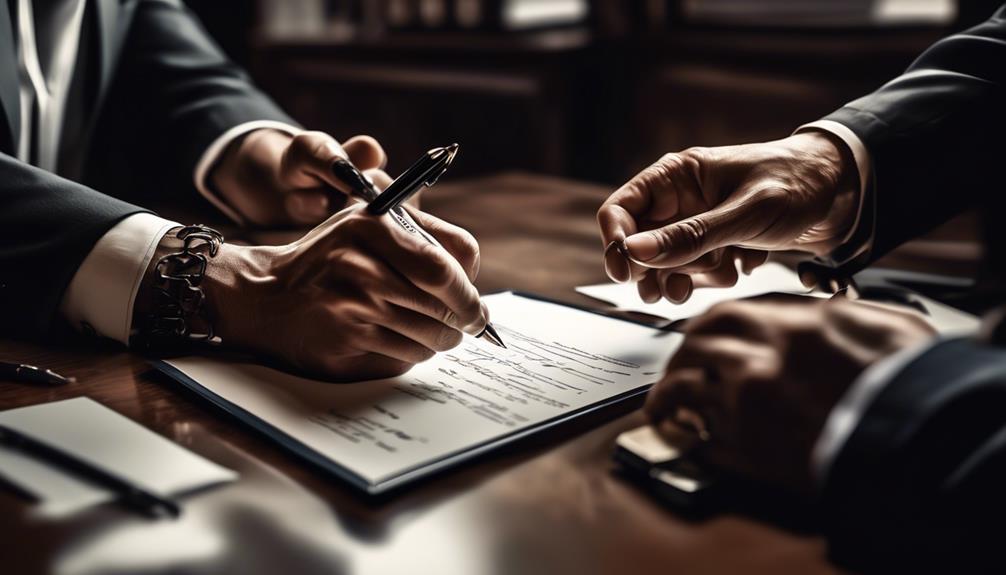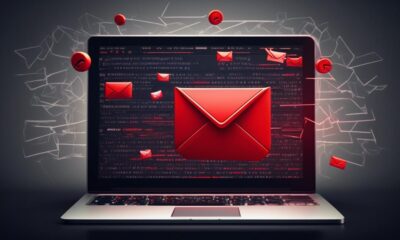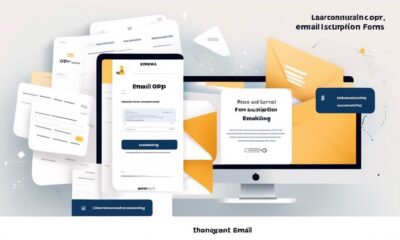How to Write Email
How to Write an Introductory Email Between Two Parties Successfully
Uncover the essential steps for crafting a professional introductory email that sets the stage for a successful connection.

Some might say that when it’s time to introduce two parties via email, it’s simpler to go ahead and make the introduction instead of seeking approval first.
However, taking the time to seek permission from both parties before making the introduction is not only courteous but also ensures that both individuals are open to the connection.
This crucial step sets the stage for a successful and well-received introduction.
Now, let's explore the best practices for crafting a professional and effective introductory email that sets the tone for a fruitful relationship between the two parties.
Key Takeaways
- Emphasize the significance of a clear and concise purpose in the introductory email.
- Obtain permission from both parties before making the introduction.
- Personalize the introduction and provide context for the introduction.
- Excuse yourself from the thread after making the introduction.
Crafting the Subject Line
Crafting the subject line for an introductory email is crucial to ensure that recipients can quickly identify the purpose of the email and prioritize it accordingly.
When introducing two parties via email, the subject line should be kept short and informative, ideally starting with 'Introduction:' or 'Intro:'. This immediately signals to the recipient that the email pertains to an introduction.
Including the first names of the individuals being introduced in the subject line personalizes the email and catches the recipients' attention. If relevant, mentioning the names of their companies in the subject line can provide context and establish relevance.
The primary goal is to help recipients swiftly identify the email's purpose and make it easy for them to find and prioritize it among the multitude of emails they receive.
Structuring the Greeting

After crafting a clear and informative subject line to grab the recipients' attention, the next crucial step is structuring the greeting with an appropriate and personalized salutation.
When structuring the greeting in an introduction email, it's important to follow these key guidelines:
- Use the recipients' first names and, if applicable, the names of their companies to address them in the greeting.
- Personalize the opening sentence to create a warm and genuine tone for the introduction, making the recipients feel valued and respected.
- Clearly state the purpose of the introduction, setting the stage for the ensuing communication and potential collaboration.
- Suggest a specific call-to-action to propel the interaction forward, such as scheduling a call or meeting to discuss potential opportunities.
- Conclude the email by politely excusing yourself from the thread, encouraging the introduced parties to engage further, and offering to step back from the conversation if necessary.
Writing the Opening Sentence
We are pleased to introduce our colleague, [First Name], to you and the team at [Company Name], with whom we believe there may be valuable opportunities for collaboration.
The opening sentence of an introductory email holds significant importance as it sets the tone for the entire communication. By personalizing the introduction with the first names of the individuals being introduced, a friendly and approachable atmosphere is established from the outset.
Addressing the recipient directly in the opening sentence not only demonstrates focus but also conveys a sense of purpose. Additionally, including the names of the respective companies adds context and relevance to the introduction, laying the groundwork for potential future interactions.
Crafting the opening sentence with a clear purpose and an appropriate greeting ensures that the email begins on a positive note and captures the recipient's attention. Adhering to email etiquette and structuring the opening sentence in a professional, concise manner sets the stage for a successful introduction that encourages meaningful connections.
Introducing Both Parties

Let's talk about how to introduce both parties in a way that sets the stage for a successful exchange.
Sharing names and roles, highlighting shared connections, and identifying mutual interests are key components to consider.
Names and Roles
Introducing both parties in an introductory email requires careful consideration and respect for their roles and names. When introducing two people in a professional email, it's essential to use their full names and titles, showing respect for their positions. Additionally, it's crucial to clearly state the role or connection that each party has with the other, ensuring that the recipient understands the context of the introduction.
Using an Email Template can help streamline this process, providing a consistent format for making the connection. Always double-check the spelling of names and the accuracy of titles to convey professionalism and attention to detail.
By following these guidelines, introductions can be made seamlessly and respectfully.
- Use full names and titles
- Clearly state roles or connections
- Utilize an Email Template
- Double-check spelling and accuracy
- Convey professionalism and attention to detail
Shared Connections
Transitioning from the importance of names and roles in introductions, ensuring a smooth and respectful introduction between parties involves understanding and respecting shared connections. When introducing two people, it's crucial to acknowledge any shared connections they may have. This can help establish common ground and facilitate a more productive interaction. Below is an example of how shared connections can be introduced in an email:
| Shared Connection | Relevance | Impact |
|---|---|---|
| Same alma mater | Professional networking | Establishes a common background |
| Previous collaboration | Business opportunities | Highlights past successful teamwork |
| Mutual acquaintance | Trust and credibility | Builds immediate rapport |
Mutual Interests
In our interactions, finding mutual interests and aligning our respective passions is key to fostering a meaningful connection between both parties. When introducing two individuals, it's essential to identify shared interests that serve as a foundation for their potential collaboration and relationship.
Here are some important aspects to consider when identifying mutual interests in an introductory email:
- Highlight common hobbies or leisure activities to facilitate a more personal connection
- Emphasize similar professional goals or industry-related passions to establish a basis for collaboration
- Acknowledge shared values or beliefs that can create a sense of camaraderie
- Recognize mutual connections or acquaintances as a way to establish trust and credibility
- Showcase complementary skills or expertise that can lead to synergistic opportunities
Conveying the Purpose

We need to clearly communicate the purpose of the introduction in the email to ensure that both parties understand the objective of the connection.
By explaining the reasons for the introduction and the potential benefits for both parties, we can effectively convey the intent behind the email.
Providing relevant context will help ensure that the introduction is mutually beneficial and valuable.
Clear Purpose Communication
Frequently, I find that clearly stating the purpose and benefit of an introduction in an email sets the stage for effective communication between the parties involved.
When introducing someone, it's crucial to make sure the subject line is clear and concise, indicating the purpose of the email.
Additionally, providing context for the introduction in a professional tone helps the parties understand the significance of the connection.
Before making the introduction, obtaining permission from both parties is essential to ensure willingness and receptiveness.
Keeping the introduction concise and highlighting the relevant background of each person can facilitate a smoother initial interaction.
Lastly, encouraging direct communication between the introduced parties and suggesting a call to action can lead to productive outcomes.
Direct Objective Conveyance
After clearly setting the stage for effective communication by emphasizing the importance of a clear and concise purpose in the introductory email, it's essential to directly convey the objective of the introduction to the involved parties.
When introducing two people via email, it's often necessary to clearly state the purpose of the introduction. Whether it's asking for permission to connect the parties or simply facilitating a new professional relationship, the objective should be conveyed with clarity and brevity.
Direct objective conveyance involves succinctly expressing the reason for the introduction and what action, if any, is expected from the recipients. This helps in ensuring that the purpose of the email is understood, and encourages prompt communication and follow-up between the introduced parties.
It's also important to respect the preferences of the individuals involved, being open to declining if necessary.
Effective Intent Expression
To effectively convey the purpose of an introduction, it's crucial to clearly articulate the intended outcome in the subject line of the email. This ensures that the recipients quickly understand the objective of the email.
When expressing intent in an introduction email, it's important to consider the following:
- Obtain permission from both parties before making the introduction to maintain respect and avoid compromising anyone's position.
- Use a professional email to provide context and explain the reasons why the individuals should meet.
- Encourage the person seeking the connection to provide a brief introduction about themselves to accurately convey the purpose of the introduction.
- Conclude the introduction email by suggesting a call to action and excusing yourself from the thread to encourage direct communication between the introduced parties.
Properly Closing the Email

In closing the introductory email, we express our willingness to step back from the thread after facilitating the introduction and encourage the introduced parties to take the lead in further communication. It's important to let the recipients know that we're available to be removed from the email thread if they prefer to connect directly. Prompt communication is essential, and we hope for a successful connection between the introduced parties.
When choosing a sign-off, it's crucial to maintain professionalism and warmth based on the relationship with both individuals. This could include using 'Best regards,' 'Sincerely,' or 'Warm regards,' depending on the level of formality and familiarity with the recipients. It's important to ensure that the sign-off aligns with the tone and context of the introductory email.
Requesting Permission for the Introduction

Before making an introduction via email, it's crucial to obtain consent from both parties involved. We should always seek formal permission and obtain approval before proceeding with the introduction.
It's important to ensure that both individuals are comfortable with the introduction and have expressed mutual interest in connecting with each other.
Seeking Formal Permission
We always ensure to seek formal permission from both parties before making any introductions.
When seeking formal permission for an introductory email, it's essential to remember that double opt-in introductions are the best approach.
Not asking for permission is lazy and can put your connections in a compromising position. People may feel obligated to respond even if they don't want to be involved.
Additionally, if someone asks for an introduction you're not comfortable with, it's important to politely decline.
Seeking formal permission from the person being introduced and the person to whom the introduction is being made is a sign of respect and consideration for their time and preferences.
Obtaining Approval
Seeking formal approval from both parties involved in the introduction is a fundamental step in ensuring a respectful and considerate approach to making connections. Before making the introduction, it's crucial to obtain approval from both individuals to ensure that they're open to being introduced to each other.
This process, often referred to as a 'double opt-in' introduction, requires obtaining the green light from both parties. Not asking for permission before making an introduction can be perceived as lazy and may put your connections in a compromising position.
It's essential to introduce both parties only if you have obtained approval from each of them. By doing so, you demonstrate a respectful and considerate approach to making the introduction, which can lead to more fruitful connections.
Step-by-Step Instructions for Writing

With a focus on double opt-in introductions, it's important to ensure that both parties have given their permission before proceeding with the introduction via email. When writing an introductory email between two parties, follow these step-by-step instructions to ensure a successful and respectful introduction:
- Obtain explicit permission from both parties before making the introduction to ensure their consent.
- Personalize the introduction and provide context for the introduction to both parties to make it more meaningful and relevant.
- Encourage the person seeking the connection to provide a short blurb about themselves to include in the introduction email, helping to facilitate a more engaging and personalized interaction.
- When excusing yourself from the email thread, emphasize the importance of prompt communication and encourage further interaction between the introduced parties, fostering a proactive and ongoing connection.
The Fastest Way to Compose Introductory Emails

After obtaining explicit permission from both parties and emphasizing the importance of prompt communication, the fastest way to compose introductory emails is to personalize the introduction and provide context for a meaningful and relevant connection. This ensures that the email is both respectful and contextually relevant. Here's a practical approach to composing introductory emails quickly:
| Step | Description |
|---|---|
| Gather necessary information | Obtain relevant details about each party to personalize the introduction. |
| Craft a concise yet warm greeting | Address both parties warmly but concisely to set a friendly tone. |
| Provide context and purpose | Clearly state the reason for the introduction and how each party can benefit from the connection.
Networking Email Guide and Templates

Let's explore the crucial points of networking emails, including email basics, effective templates, and networking tips.
These elements are essential for creating professional and impactful introductory emails in various networking scenarios.
Email Basics
How can we craft effective networking emails that garner positive responses and build strong connections?
When it comes to the basics of writing an introductory email, there are several key points to consider:
- Respect permission: Always ensure that you have obtained permission before introducing two parties via email.
- Clear and concise: Keep the email brief and to the point, introducing the parties and clearly stating the purpose of the introduction.
- Personalization: Tailor the email to the specific individuals being introduced, highlighting any common interests or connections.
- Professional tone: Maintain a professional and respectful tone throughout the email, reflecting the seriousness of the introduction.
- Follow-up plan: Consider including a plan for follow-up communication or a request for confirmation of receipt and interest.
These basics are essential for crafting effective and impactful networking emails.
Effective Templates
We have compiled a comprehensive set of effective templates for crafting networking emails, providing valuable guidance and practical examples for successful introductions.
Our templates cover various scenarios, such as introducing two parties for professional networking or personal connections.
Each template is designed to help you navigate the introduction process with ease and professionalism. These templates are tailored to ensure that your emails are clear, concise, and respectful of both parties' time.
Whether you're initiating the introduction or facilitating a mutual connection, our templates offer a strategic approach to crafting effective emails that resonate with the recipients.
Networking Tips
In our exploration of effective templates for introductory emails, we now shift our focus to essential networking tips, encompassing a comprehensive guide and practical templates for successful networking emails.
When it comes to networking, it's crucial to ask for permission before making an introduction. Requesting a blurb from the person who asked for the intro is a key step in the process.
Additionally, we'll provide step-by-step instructions on writing an introduction email to ensure clarity and professionalism. Excusing yourself from the thread after making the introduction is also a courteous gesture.
These networking tips will help in establishing meaningful connections and fostering productive relationships.
Writing a Follow-Up Email

After securing permission for the introduction, a well-crafted follow-up email can help maintain the momentum of the initial connection. When crafting a follow-up email, it's essential to reintroduce yourself and remind the recipient of the context in which you were introduced. This can help to jog their memory and establish a connection. Be clear and concise about your purpose for reaching out and express gratitude for the initial introduction. It's important to respect the recipient's time, so keep the email brief and to the point.
In the follow-up email, it's also beneficial to suggest a specific action or next steps, such as scheduling a meeting or call to further discuss potential collaboration. This demonstrates your proactive approach and willingness to engage in meaningful dialogue. Additionally, be sure to offer something of value in return, whether it's sharing relevant resources, insights, or simply expressing your eagerness to learn more about their work.
Lastly, always maintain a professional and courteous tone throughout the follow-up email. Remember to conclude the email with a clear call to action, inviting the recipient to respond at their earliest convenience. By following these guidelines, you can effectively nurture the initial connection and pave the way for a fruitful relationship.
Conducting a Double-Opt-In Intro

Transitioning from the discussion on crafting a follow-up email, it's essential to ensure a warm and meaningful introduction by conducting a double-opt-in intro. When conducting a double opt-in intro, it's crucial to respect the privacy and time of each party involved. Here are some key points to consider:
- Respecting Privacy: Ensure that both parties are open to the introduction before proceeding.
- Individual Outreach: Reach out to each person separately to gauge their interest in connecting.
- Considerate Declines: If one party declines, be courteous and either decline the meeting with the other person or find an alternative solution.
- Setting the Stage: Conducting a double opt-in intro sets the stage for a more meaningful and productive introduction.
- Interest Alignment: It ensures that both parties are genuinely interested in connecting, fostering a more authentic and valuable interaction.
Maximizing the Power of Advanced Analytics

Leveraging the power of advanced analytics transforms raw data into actionable insights, driving informed decision-making and empowering organizations to achieve strategic objectives.
With advanced analytics, organizations can uncover hidden patterns, trends, and insights within their data, enabling them to make well-informed choices. This approach goes beyond traditional descriptive analytics, allowing for predictive and prescriptive analysis, leading to proactive problem-solving and improved outcomes.
By harnessing the potential of advanced analytics, businesses can optimize processes, enhance customer experiences, and drive innovation. The implementation of advanced analytics can result in improved operational efficiency, cost savings, and a competitive advantage in the market.
As we delve into the intricacies of writing an introductory email between two parties, it's essential to recognize the pivotal role that advanced analytics plays in shaping strategic decisions and fostering organizational success. Understanding the impact and potential of advanced analytics is crucial in crafting effective communication and building fruitful partnerships.
Key Elements of an Introduction Email

Understanding the pivotal role that advanced analytics plays in shaping strategic decisions and fostering organizational success, we now move on to explore the key elements of an introduction email.
When crafting an introduction email between two parties, it's essential to consider the following key elements:
- Permission: Always ask for permission from both parties before making the introduction. Double opt-in introductions are the best approach to ensure that both parties are open to the connection.
- Professionalism: Write a professional email to the person your connection wants to meet. Clearly provide context for the introduction and explain the potential value of the connection.
- Respect boundaries: If someone asks for an introduction that you're not comfortable with, politely decline. Not asking for permission is lazy and can put your connections in a compromising position.
- Clarity and context: Provide clear and relevant information about each party to facilitate a meaningful connection.
- Follow-up: After making the introduction, follow up with both parties to ensure that the connection was successful and offer any additional assistance if needed.
Common Mistakes to Avoid

In introducing the common mistakes to avoid when writing an introductory email, it's imperative to emphasize the importance of personalization and context to ensure the effectiveness of the communication.
One common mistake is the lack of personalization, where generic emails are sent without tailoring the content to the recipients. It's crucial to introduce each party in a way that highlights the mutual benefits of the introduction, demonstrating a clear understanding of their respective backgrounds and interests.
Additionally, providing enough context about both parties is essential. This helps the recipients understand the relevance and purpose of the introduction.
Another common mistake is creating lengthy and verbose emails. It's important to keep introductory emails concise and to the point, respecting the recipients' time and attention.
Furthermore, it's essential to follow email introduction etiquette, such as obtaining permission before making an introduction. Respect for privacy and consent is paramount in email communication.
Is there a Difference Between an Introductory Email and an Introduction Email Between Two Parties?
Yes, there is a difference between an introductory email and an introduction email between parties. An introductory email is a first contact email where you introduce yourself, while an introduction email between parties is when you introduce two parties to each other. Both are important in professional writing introduction email between parties.
Frequently Asked Questions
How Do You Write an Email Introduction Between Two Parties?
We typically start by outlining the importance of obtaining permission before making introductions.
Then, we emphasize the effectiveness of the double opt-in approach and encourage the inclusion of a blurb.
Our step-by-step approach ensures an effective and respectful introduction email.
It's crucial to maintain professionalism, clarity, and conciseness in the email, catering to an audience that seeks mastery in this field.
How Do You Write an Introductory Email?
We write an introductory email by crafting a clear, concise, and respectful message. It should express the mutual benefit of the introduction and seek permission from both parties.
A double opt-in approach ensures that all involved are comfortable with the connection. We should always respect any declines and address both parties separately in the request.
This approach fosters positive and respectful connections between individuals.
How Do You Introduce Two People to Each Other?
We introduce two people by obtaining permission from both parties and crafting a professional email with context for the introduction.
It's essential to keep the email concise and informative, including relevant background information about each person.
We also consider asking for a blurb from the person requesting the introduction to provide accurate context.
How Do You Introduce Two People in an Email Subject Line?
Introducing two people in an email subject line sets the tone for the entire message. It's crucial to be clear and concise while capturing the essence of the introduction.
A strong subject line can pique the recipients' interest and encourage them to open the email. It should convey the purpose of the introduction and entice the readers to engage with the email content.
Conclusion
In the world of business introductions, asking for permission is key. It's like knocking on the door before entering someone's home – it shows respect and consideration.
By following the steps outlined in this article, you can ensure that your introductions are professional, impactful, and well-received.
Remember, a thoughtful and well-crafted introduction can open doors and create valuable connections for all parties involved.
Natali – Editor in Chief (Strategy and Mastery, AI Expert) Natali, our Editor in Chief, is the driving force behind our content’s strategic direction. With a keen eye for detail and a deep understanding of market trends, Natali ensures that our content is top-notch and strategically aligned with our client’s goals. Her expertise in AI helps to seamlessly integrate advanced technology into our marketing strategies, pushing the boundaries of conventional marketing.
How to Write Email
Crafting a Polished PTO Request Email
Need guidance on crafting a professional PTO request email? Learn key tips and essential components to ensure your request stands out.

As professionals in our specific fields, we all understand the importance of striking a balance between our work responsibilities and personal lives.
However, when it comes to requesting PTO, it can be a delicate task to navigate. Finding the right balance between being concise and providing all necessary information can be challenging, but it’s essential for a successful request.
In this discussion, we’ll explore the key components of crafting a well-written PTO request email, ensuring that your request is clear, professional, and respectful of your supervisor’s time.
Key Takeaways
- PTO plays a crucial role in maintaining work-life balance and employee well-being.
- Open communication with managers is essential for effective leave planning.
- Crafting a well-written PTO request email involves using a clear subject line, stating the reason for the request, expressing gratitude, and offering assistance during absence.
- PTO management tools simplify the process of requesting and managing leave, reducing scheduling conflicts and ensuring adequate staffing.
Understanding PTO and Its Importance
Understanding the significance of PTO in maintaining a healthy work-life balance is crucial for both employees and the overall company culture. PTO, or paid time off, plays a vital role in ensuring that employees have the opportunity to rest, recharge, and tend to personal matters without compromising their financial security.
It’s important for employees to have a clear understanding of PTO policies, which are typically outlined in the employee handbook or company policy documents. Open communication with managers or supervisors regarding PTO usage is essential for planning leave requests effectively.
By recognizing the importance of work-life balance, employees can proactively manage their time off, providing ample notice for planned absences and ensuring minimal disruption to workflow. Furthermore, a company culture that values and encourages the use of PTO fosters employee well-being, satisfaction, and productivity.
It’s crucial to acknowledge the correlation between taking time off and preventing burnout, as well as the positive impact it has on overall job performance and satisfaction.
Crafting a Clear and Persuasive Email

Crafting a clear and persuasive email to request PTO requires careful attention to detail and a thoughtful approach that effectively communicates the need for time off. Start by crafting a clear and concise subject line that summarizes the purpose of the email.
When writing the body of the email, clearly state the reason for the PTO request, including specific dates and the type of leave being requested. It’s important to provide a brief explanation of the importance of the requested time off, emphasizing the positive impact on work-life balance and overall well-being.
Express gratitude and maintain a professional and respectful tone throughout the email.
End the email with a willingness to discuss the request further and offer assistance in ensuring a smooth transition during the absence. This approach helps to ensure that your email is persuasive and effectively conveys the need for time off to your manager or team.
Tips for Writing a Professional Email
When requesting PTO, it’s essential to maintain a professional tone and adhere to specific guidelines for crafting a clear and persuasive email. Here are some tips for writing a professional email to request vacation time off.
Firstly, ensure the subject line clearly indicates the purpose of the email, such as ‘Request for PTO: [Your Name].’ This helps the recipient understand the email’s content at a glance.
Next, address the recipient with a formal salutation, using ‘Dear [Manager’s Name]’ or ‘Hello [Manager’s Name]’ to maintain professionalism.
In the body of the email, clearly state the purpose of the email, including the dates for which you’re requesting PTO and any pertinent details related to your request. Be sure to adhere to company policy and provide ample notice if required.
Use polite and respectful language throughout the email to convey your request professionally.
Finally, close the email with a professional sign-off, such as ‘Sincerely’ or ‘Best regards,’ and include your contact information for further communication if necessary.
Examples of Effective Time Off Request Emails

We are writing to request time off from [specific start date] to [specific end date] for personal reasons. According to our company’s vacation policy, we understand the importance of providing advance notice and making a formal request for vacation time.
To ensure a successful request, it’s crucial to write a vacation request email with a clear subject line and a professional tone in the body of the email. When composing the email, it’s essential to clearly state the reason for your vacation and adhere to the specific dates required. Additionally, it’s important to adhere to the company’s vacation policy and any specific procedures outlined for requesting time off.
- State the specific dates for the requested time off.
- Clearly outline the reason for the time off.
- Express gratitude for the consideration of the request.
Simplifying Time off Requests With PTO Tools
By utilizing PTO management tools such as Flamingo, companies can streamline the process of requesting and managing leave, allowing employees to submit their requests directly from Slack and enabling managers or supervisors to promptly approve or deny them while maintaining an updated leave calendar. This simplifies time off requests, creates a paper trail, and ensures that the vacation policy is adhered to. PTO tools like Flamingo also make it easier for employees to let their manager know about their vacation plans, reducing the likelihood of scheduling conflicts and ensuring that the team is adequately staffed at all times. The use of these tools helps in avoiding the back-and-forth of vacation request emails and sample vacation request emails, making the entire process efficient and transparent. Here’s an example of a simplified time off request process using PTO tools:
Benefits of PTO Tools Streamlined process Direct Slack submission Prompt approval/denial
Frequently Asked Questions
How Do You Write a Formal Email Request?
We write a formal email request with a clear subject line, specified dates, and a friendly tone.
Understanding the benefits of PTO and its impact on work-life balance is crucial.
Providing a status update upon return and arranging coverage during absence are essential.
Familiarizing ourselves with company policies, considering paid versus unpaid time off, and asking for time off at the right time are necessary.
We express willingness to address concerns, be polite and appreciative, and provide assurance that work will be covered.
How Do You Write a Day off Request Email?
When writing a day off request email, we keep it professional, brief, and polite. We express gratitude for the opportunity and clearly state the dates and reason for the request.
We ensure the recipient understands that we’ve considered any potential impact on work and have a plan to address it. It’s crucial to follow any specific company procedures for requesting time off and to be open to discussing any adjustments if needed.
How Do You Politely Ask for Leave in an Email?
When politely asking for leave in an email, we ensure to be concise, providing specific dates and reasoning. We maintain a professional tone and express gratitude for considering our request.
Including a subject line that clearly states the purpose aids in effective communication. It’s important to highlight our commitment to completing pending tasks and offering a plan for coverage during our absence.
Clear communication helps in getting our leave approved.
How Do I Request a PTO Email Example?
Sure, requesting a PTO email example is a common need. We can provide a clear and professional sample that you can use as a template.
It’s essential to tailor it to your specific situation and company culture. We’ll include a polite tone and necessary details for an effective request.
This example will serve as a helpful guide for crafting your own PTO request email.
Conclusion
In conclusion, requesting time off is an essential part of maintaining a healthy work-life balance. By following the tips and examples provided, you can craft a persuasive and professional PTO request email that will help you secure the time off you need.
Remember to be proactive in preparing for your absence and to show appreciation for your supervisor’s understanding. With the right approach, you can make the process of requesting time off as smooth as butter.
Erik – Email, SEO, AI Expert Writer Erik is the strategist, the thinker, and the visionary. His role at Influenctor is pivotal in integrating SEO with AI-driven content strategies. With an extensive background in email marketing and a profound understanding of search engine algorithms, Erik develops innovative strategies that elevate our client’s online presence. His work ensures that our content is seen, felt, and remembered.
How to Write Email
How to Write Effective Team Email Communications
Bolster your team communication with expert email writing tips that will enhance productivity and collaboration like never before.

In today’s modern office settings, emails are now seen as the online version of a handshake when it comes to conducting business. It is crucial to carefully craft our emails as they can either help us succeed or result in confusion and miscommunication.
Mastering the art of writing emails to team members is more than just a skill; it's a strategic tool for fostering collaboration and productivity within our teams.
So, how can we ensure that our emails are not just another unread message in an overflowing inbox? Let's explore the key principles that can transform our emails into effective and engaging communication channels, ultimately strengthening our team dynamics and achieving our collective goals.
Key Takeaways
- Clear and concise communication through emails is crucial for avoiding misunderstandings and maintaining a positive company culture.
- Crafting engaging subject lines can increase open rates and set expectations for the purpose of the email.
- Conveying vital information in emails should prioritize essential details, maintain transparency, and be free of errors.
- Fostering a positive team dynamic involves promoting collaboration, transparency, regular communication, and professionalism in emails.
Importance of Clear Communication
Clear communication via email is crucial for avoiding misunderstandings and maintaining a healthy company culture. When crafting professional emails, it's essential to be clear and concise to ensure that the intended message is effectively conveyed.
Our communication skills, reflected in the emails we send, play a pivotal role in engaging and informing our colleagues. A substantial percentage of employees ignoring work emails emphasizes the importance of writing emails that captivate and inform them efficiently.
By mastering the art of clear and transparent communication, we can foster trust and engagement among our team members, thereby positively impacting the overall workplace environment. The writing style of our emails significantly influences how the message is received and understood by the recipients. Therefore, it's crucial to maintain professional and consistent communication in emails to establish a positive and productive work environment.
As we delve into the intricacies of writing email to team members, honing our ability to craft clear, professional, and engaging emails will undoubtedly enhance our effectiveness in communicating within the organization.
Crafting an Engaging Subject Line

Mastering the art of clear and transparent communication through engaging subject lines is crucial for capturing our team members' attention and setting clear expectations for our emails. When crafting subject lines for our emails, we should keep in mind the following:
- Be Specific and Attention-Grabbing: Use subject lines that are specific to the content of the email and grab the recipient's attention. This can increase open rates and ensure that the email isn't overlooked in a crowded inbox.
- *Example*: 'Action Required: Review and Approve Q3 Budget Proposal'
- Clearly State the Purpose: The subject line should clearly state the purpose of the email, setting the right expectations for recipients. This helps in ensuring that the email is read and acted upon promptly.
- *Example*: 'Invitation: Team Building Event RSVP Needed by Friday'
Crafting engaging subject lines is an essential skill in writing professional emails. By using impactful language, being specific, and reflecting the urgency and importance of the message, we can increase the likelihood of our team members engaging with the content of our emails.
Conveying Vital Information
We consistently convey vital information to our team members through clear and engaging email communication, ensuring that important messages are effectively delivered and understood.
When writing employee emails, it's crucial to prioritize essential information, leading with the most critical details to grab attention and maintain the reader's focus. By using attention-grabbing subject lines, we can convey the urgency of the message and ensure that employees understand the importance of the content.
Maintaining transparency, positivity, and consistency in our communication helps to build trust and engagement with our team members.
Furthermore, ensuring that our emails are free of spelling mistakes, grammatical errors, and typos is essential for maintaining professionalism and credibility.
Clear and concise communication is key when conveying vital information, and it's important to craft emails that aren't only informative but also engaging and easy to understand. This approach fosters a healthy company culture and keeps employees actively involved and informed.
Fostering a Positive Team Dynamic

Fostering positivity within the team dynamic enhances collaboration and productivity. To achieve this, transparency about major developments and progress should be prioritized. Consistently sending regular emails fosters the habit of reading and engagement among team members, promoting a sense of unity and shared purpose.
Additionally, designing a template for important company-wide emails with a professional look can maintain branding and visual appeal, setting a positive tone for communication. Furthermore, ensuring that emails are free of spelling mistakes, grammatical errors, and typos is essential for quality assurance and to convey professionalism.
It's also crucial to consider the message, audience reaction, and audience size when deciding when to send an email, as this demonstrates respect for the recipients' time and attention.
Ensuring Professionalism and Clarity
How can we ensure that our team emails convey professionalism and clarity in every communication? To ensure our team emails maintain a professional tone and convey information clearly, we need to pay attention to several key elements. Here are some strategies to consider:
| Element | Description | Example |
|---|---|---|
| Clear and Specific Subject Line | Use a subject line that accurately summarizes the content and urgency of the email. | "Action Required: Review Meeting Agenda" |
| Professional Greeting and Introduction | Begin the email with a polite greeting and a concise introduction of the email's purpose. | "Dear Team, I hope this email finds you well. I am writing to inform you about the upcoming project." |
| Focused and Concise Body | Keep the email body focused on essential information, using short paragraphs and a clear call to action. | "Please review the attached document and provide your feedback by Friday." |
Frequently Asked Questions
How Do You Write an Email to the Whole Team?
When we write an email to the whole team, it's crucial to capture everyone's attention right from the subject line. We need to lead with the most important information and maintain transparency, positivity, and consistency in our communication.
This ensures that our message is clear and well-received by all team members. By following these guidelines, we can effectively communicate with the entire team and maintain a healthy company culture.
How Do You Write a Formal Email to a Staff?
We write formal emails to our staff members with a respectful tone and clear, concise language. We start with a polite greeting and then dive into the main subject.
Our message is professional, yet approachable, and we always include all necessary details. We ensure that our email is well-structured, error-free, and follows the company's communication guidelines.
Lastly, we end with a courteous closing and our contact information.
How Do You Share Information With Team Members Email?
When sharing information with team members via email, we ensure clarity, brevity, and positivity. We grab attention with an engaging subject line, using numbers or emotional language.
We lead with the most important information, maintaining transparency and consistency. Regular updates and a positive tone are crucial. We aim to avoid misunderstandings and effectively engage our employees, ensuring our emails are concise, organized, and impactful.
How Do You Write a Letter to a Team Member?
When writing a letter to a team member, we aim to communicate clearly and concisely to convey important information.
We should ensure that the subject line is specific and relevant, grabbing the recipient's attention.
Our goal is to maintain transparency and build trust through our correspondence. By doing so, we foster a healthy company culture and keep our team engaged.
Our emails should be brief, yet informative, to effectively share updates and progress.
Conclusion
In conclusion, clear and effective communication is the foundation of a successful team. By mastering the art of email writing, we can keep our team members informed, engaged, and motivated.
It's through transparent and positive communication that we can foster a strong team dynamic and maintain professionalism. So, let's keep our emails concise yet impactful, and always strive for clarity and consistency in our communication.
Erik – Email, SEO, AI Expert Writer Erik is the strategist, the thinker, and the visionary. His role at Influenctor is pivotal in integrating SEO with AI-driven content strategies. With an extensive background in email marketing and a profound understanding of search engine algorithms, Erik develops innovative strategies that elevate our client’s online presence. His work ensures that our content is seen, felt, and remembered.
How to Write Email
How to Write an Apology Email After Missing a Meeting
Master the art of crafting a compelling apology email for missing a meeting and mend professional relationships with finesse.

We’ve all been in situations where skipping a meeting is like missing the last puzzle piece. It’s not the end of the world, but it leaves a sense of incompleteness. Anyone can relate to that empty feeling. Don’t miss out on the opportunity to connect and collaborate with others. Joining meetings can lead to valuable insights and connections. Don’t miss the chance to be a part of the bigger picture.
So, how do we convey our apologies in a way that not only acknowledges the inconvenience caused but also sets the stage for a potential rescheduling?
Well, let’s explore the art of crafting an apology email for missing a meeting and how it can pave the way for rebuilding professional rapport.
Key Takeaways
- Apologizing and taking responsibility for missing a meeting is crucial in maintaining professional relationships and demonstrating accountability.
- Valid reasons for missing a meeting include personal emergencies, conflicting schedules, miscommunication of meeting details, technical issues, or forgetfulness.
- When apologizing for missing a meeting, reach out to the relevant parties as soon as possible, express sincere regret, offer a transparent explanation if applicable, and make amends by catching up on missed work or providing a summary of the meeting’s key points.
- To avoid future missed meetings, prioritize and organize schedules effectively, communicate potential conflicts in advance, utilize reminders and calendar apps, establish work-life boundaries, and take proactive measures to prevent future absences.
Understanding the Importance of Apologizing
Understanding the importance of apologizing is vital in maintaining professional relationships and demonstrating accountability. When we miss a meeting, it’s essential to acknowledge the significance of the gathering and offer a sincere apology. Taking responsibility for our absence and recognizing any inconvenience caused is crucial.
We must understand that our actions can impact others and acknowledging the importance of the meeting in our apology email is a way to show that we value the time and efforts of our colleagues. By offering an explanation, if applicable, we can provide context for our absence and show that we understand the impact of our actions.
Maintaining professional relationships requires us to be empathetic and considerate of others’ time. Therefore, understanding the importance of apologizing in this context isn’t just about saying sorry; it’s about demonstrating respect, accountability, and a genuine desire to make amends.
In doing so, we can repair any damage caused by our absence and work towards rebuilding trust and goodwill.
Reasons for Missing a Meeting

Apologies for missing a meeting can stem from a variety of reasons, including personal emergencies, conflicting schedules, miscommunication of meeting details, technical issues, or simply forgetfulness.
When crafting an apology email for missing an important meeting, it’s crucial to acknowledge the reason for the absence. A personal emergency, such as a sudden illness or family crisis, is a valid reason for missing a meeting. Conflicting schedules may arise due to prior commitments or unforeseen work demands. Miscommunication of meeting details, like time or location, can lead to unintentional absence. Technical issues, such as internet connectivity problems or software malfunctions, might prevent attendance despite the best efforts. Lastly, forgetfulness can cause an unintentional absence from a meeting.
Whatever the reason, it’s essential to sincerely apologize for missing the meeting, express understanding of the inconvenience caused, and offer to make amends. By addressing the specific reason for missing the meeting in a professional apology email, it demonstrates a commitment to maintaining a positive relationship and ensuring future attendance.
Steps to Apologize for Missing a Meeting
After acknowledging the various reasons for missing a meeting, it’s important to understand the steps involved in crafting a sincere apology email.
Firstly, reaching out to the relevant parties as soon as possible is crucial. Promptly acknowledging the absence demonstrates professionalism and respect for others’ time.
Secondly, the apology email should be sincere and apologetic. Expressing regret for missing the meeting and acknowledging the inconvenience caused can go a long way in rebuilding trust and maintaining positive professional relationships. Additionally, if there’s a valid explanation for the absence, it should be offered in a transparent and honest manner. However, it’s important to avoid making excuses and instead focus on taking responsibility for the missed meeting.
Making amends is another vital step in the process of apologizing for missing a meeting. Offering to catch up on missed work or providing a summary of the meeting’s key points can help mitigate the impact of the absence.
Lastly, following up after sending the apology email shows a commitment to rectifying the situation and ensuring that the relationship remains positive and professional.
Please accept our sincerest apology for any inconvenience caused by our absence at the meeting.
Apology Email Templates

We understand the importance of crafting sincere and empathetic apology emails when missing a meeting, and providing appropriate templates can help streamline this process for professionals.
When drafting an apology email for missing a meeting, it’s essential to show respect, express regret, and offer a brief explanation if applicable.
One template approach is to apologize for any inconvenience caused by the absence and express regret for not being able to attend. Additionally, it’s important to suggest alternative dates and times to reschedule the meeting, demonstrating a commitment to making amends.
Another template could involve expressing regret and acknowledging the inconvenience caused, while also offering to make amends by proposing alternative ways to catch up on the missed meeting points.
It’s crucial to maintain a professional tone throughout the email and thank the recipient for their understanding.
Maintaining Work-Life Balance to Avoid Future Missed Meetings
To maintain a healthy work-life balance and minimize the risk of missing future meetings, it’s crucial to prioritize and organize our schedules effectively. Balancing work hours with personal time is essential for honoring our commitments and showing respect for others’ time.
It’s important to communicate any potential scheduling conflicts with colleagues in advance, as this demonstrates our commitment to our professional responsibilities. Setting reminders and utilizing calendar apps can help us stay on top of meeting times and avoid forgetfulness.
Additionally, establishing clear boundaries between work and personal life can help prevent burnout and reduce the risk of missed meetings due to personal emergencies. By maintaining a work-life balance, we show our dedication to our work while also acknowledging the importance of personal well-being.
When it comes to addressing missed meetings, it’s crucial to avoid making excuses and instead take responsibility for the inconvenience our absence may have caused. This approach demonstrates professionalism and a proactive attitude towards preventing future missed meetings.
Frequently Asked Questions
How Do You Apologize for Missing Meetings in an Email?
We apologize for missing meetings in an email by promptly acknowledging the oversight, explaining the reason for our absence, and expressing our regret.
It’s crucial to convey sincerity and understanding while offering a solution to mitigate any inconvenience caused.
By taking responsibility and showing empathy, we can maintain professionalism and strengthen relationships with our colleagues.
Our approach should reflect genuine concern for their time and the impact of our absence.
How Do You Apologize Professionally for Not Attending a Meeting?
We apologize professionally for not attending a meeting. We acknowledge the inconvenience caused and express sincere regret. If applicable, we offer an explanation for our absence.
It’s important to convey gratitude for understanding and to assure the recipient of our commitment to preventing future occurrences.
Our email should maintain a polite and professional tone, demonstrating responsibility and respect for their time.
We aim to mend any disruption caused and reaffirm our dedication to the team.
How Do You Apologize Professionally in an Email?
We apologize professionally in an email by acknowledging our mistake.
We express genuine regret and offer a sincere explanation.
It’s essential to convey empathy and understanding for any inconvenience caused.
We should also assure the recipient that we’re taking steps to prevent a similar situation in the future.
How Do You Apologize for Missing Something Professionally?
We apologize for missing something professionally.
We acknowledge the mistake, expressing genuine regret.
We offer a sincere explanation if necessary.
It’s crucial to take responsibility.
We make amends and ensure it doesn’t happen again.
Communicating promptly and professionally with those affected is essential.
Conclusion
We sincerely hope that our article has been helpful in guiding you through the process of writing an apology email for missing a meeting.
Just like a warm hug on a cold day, a heartfelt apology can mend relationships and show our genuine care for others.
Thank you for taking the time to read our tips, and we wish you success in all your future professional endeavors.
Erik – Email, SEO, AI Expert Writer Erik is the strategist, the thinker, and the visionary. His role at Influenctor is pivotal in integrating SEO with AI-driven content strategies. With an extensive background in email marketing and a profound understanding of search engine algorithms, Erik develops innovative strategies that elevate our client’s online presence. His work ensures that our content is seen, felt, and remembered.
-

 Email Marketing Tools and Techniques1 month ago
Email Marketing Tools and Techniques1 month agoHow to Export Mailchimp Contacts
-

 How to Write Email2 months ago
How to Write Email2 months agoHow to Write Negative Feedback Email: Sample Guide
-

 Email Automation3 months ago
Email Automation3 months agoAutomated Email Marketing 101: A Beginner's Tutorial
-

 Marketing Strategy3 weeks ago
Marketing Strategy3 weeks agoHow to Make an Offer So Good That Customers Can’t Resist!
-

 Email Warmup3 weeks ago
Email Warmup3 weeks agoWarm Follow-Up Email
-

 GDPR Email Marketing4 weeks ago
GDPR Email Marketing4 weeks agoGDPR Email Marketing: Consent Examples Guide
-

 Email Design Hub1 month ago
Email Design Hub1 month ago3 Essential Tools for Email Marketing Design Success
-

 Email Marketing2 days ago
Email Marketing2 days agoWhat Is Email Marketing Advantages and Disadvantages



















